大纲
经过之前的若干节的学习,我们基本掌握了Rabbitmq各个组件和功能。本文我们将使用之前的知识搭建一个简单的单人聊天服务。
基本结构如下。为了避免Server有太多连线导致杂乱,下图将Server画成两个模块,实则是一个服务。
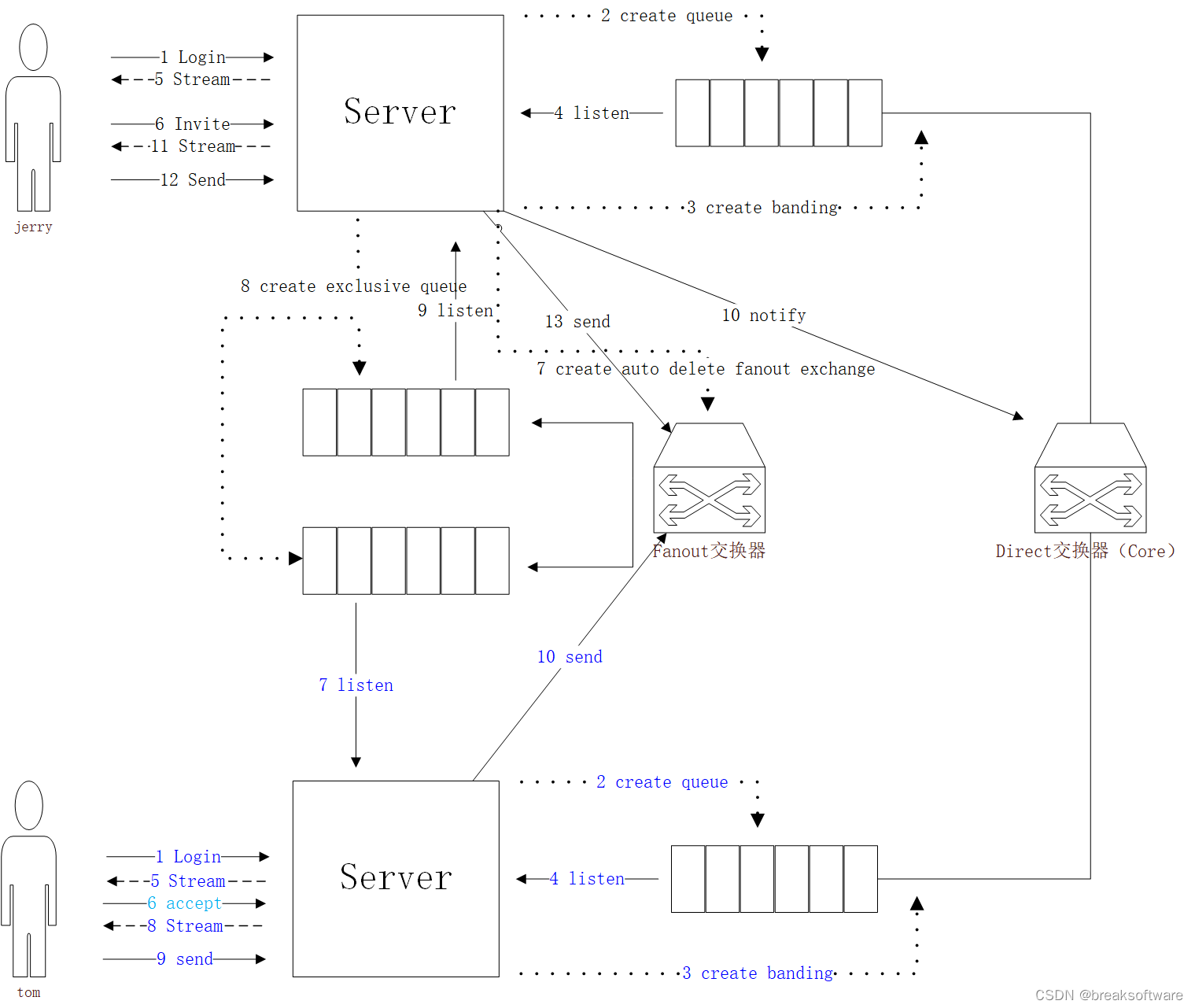
该服务由两个核心交换器构成。
Core交换器是服务启动时创建的,它主要是为了向不同用户传递"系统通知型"消息。比如Jerry向Tom发起聊天邀请,则是通过上面黑色字体6-10的流程发给了Core交换器。然后Core交换器将该条消息告知Tom。
Fanout交换器是用来消息传递的。Jerry和Tom都向其发送消息,然后路由到两个队列。它们两各自订阅一个队列,就可以看到彼此的聊天内容了。
创建Core交换器
java
package com.rabbitmq.chat.service;
import java.util.Map;
import java.util.concurrent.locks.ReentrantLock;
import org.springframework.amqp.core.Message;
import org.springframework.amqp.core.MessageListener;
import org.springframework.amqp.rabbit.connection.ConnectionFactory;
import org.springframework.amqp.rabbit.core.RabbitTemplate;
import org.springframework.amqp.rabbit.listener.SimpleMessageListenerContainer;
import org.springframework.beans.factory.annotation.Autowired;
import org.springframework.stereotype.Service;
import jakarta.annotation.PostConstruct;
import reactor.core.publisher.Flux;
@Service
public class Core {
@Autowired
private RabbitTemplate rabbitTemplate;
private ConnectionFactory connectionFactory;
final String exchangeName = "Core";
@PostConstruct
public void init() {
connectionFactory = rabbitTemplate.getConnectionFactory();
createExchange(exchangeName);
}
private void createExchange(String exchangeName) {
rabbitTemplate.execute(channel -> {
channel.exchangeDeclare(exchangeName, "direct", false, true, null);
return null;
});
}用户登录
用户登录后,我们会创建一个"系统通知"队列。然后用户就会通过长连接形式,持续等待系统发出通知。
java
private final ReentrantLock lock = new ReentrantLock();
final private Map<String, SimpleMessageListenerContainer> listeners = new java.util.HashMap<>();
public Flux<String> Login(String username) {
createExclusiveQueue(username);
createBanding(exchangeName, username, username);
return Flux.create(emitter -> {
SimpleMessageListenerContainer container = getListener(username, (Message message) -> {
String msg = new String(message.getBody());
System.out.println("Received message: " + msg);
emitter.next(msg);
});
container.start();
});
}
private void createExchange(String exchangeName) {
rabbitTemplate.execute(channel -> {
channel.exchangeDeclare(exchangeName, "direct", false, true, null);
return null;
});
}
private void createBanding(String exchangeName, String queueName, String routingKey) {
rabbitTemplate.execute(channel -> {
channel.queueBind(queueName, exchangeName, routingKey);
return null;
});
}
private SimpleMessageListenerContainer getListener(String queueName, MessageListener messageListener) {
lock.lock();
try {
SimpleMessageListenerContainer listener = listeners.get(queueName);
if (listener == null && messageListener != null) {
listener = new SimpleMessageListenerContainer();
listener.setConnectionFactory(connectionFactory);
listener.setQueueNames(queueName);
listener.setMessageListener(messageListener);
listeners.put(queueName, listener);
}
return listener;
} finally {
lock.unlock();
}
}Controller如下
java
package com.rabbitmq.chat.controller;
import org.springframework.beans.factory.annotation.Autowired;
import org.springframework.web.bind.annotation.PostMapping;
import org.springframework.web.bind.annotation.RequestMapping;
import org.springframework.web.bind.annotation.RequestParam;
import org.springframework.web.bind.annotation.RestController;
import com.rabbitmq.chat.service.Core;
import reactor.core.publisher.Flux;
@RestController
@RequestMapping("/user")
public class UserController {
@Autowired
private Core core;
@PostMapping(value = "/login", produces = "text/event-stream")
public Flux<String> login(@RequestParam String username) {
return core.Login(username);
}
}发起聊天邀请
发起聊天邀请时,系统会预先创建一个聊天室(ChatRoomInfo )。它包含上图中Fanout交换器、以及聊天双方需要订阅的消息队列。
这些创建完后,发起方就会等待对方发送的消息,也可以自己和自己聊天。因为消息队列已经创建好了,只是对方还没使用。
java
package com.rabbitmq.chat.service;
import java.util.Map;
import java.util.concurrent.locks.ReentrantLock;
import org.springframework.amqp.core.Message;
import org.springframework.amqp.rabbit.connection.ConnectionFactory;
import org.springframework.amqp.rabbit.core.RabbitTemplate;
import org.springframework.amqp.rabbit.listener.SimpleMessageListenerContainer;
import org.springframework.beans.factory.annotation.Autowired;
import org.springframework.stereotype.Service;
import jakarta.annotation.PostConstruct;
import lombok.Data;
import reactor.core.publisher.Flux;
@Service
public class ChatRoom {
@Autowired
private RabbitTemplate rabbitTemplate;
private ConnectionFactory connectionFactory;
@Data
private class ChatRoomInfo {
private String exchange;
private Map<String, String> usernameToQueuename;
}
private final Map<String, ChatRoomInfo> chatRooms = new java.util.HashMap<>();
private final ReentrantLock lock = new ReentrantLock();
@PostConstruct
public void init() {
connectionFactory = rabbitTemplate.getConnectionFactory();
}
public Flux<String> invite(String fromUsername, String toUsername) {
String chatRoomName = getChatRoomName(fromUsername, toUsername);
ChatRoomInfo chatRoomInfo = chatRooms.get(chatRoomName);
if (chatRoomInfo == null) {
createChatRoom(fromUsername, toUsername);
}
return talk(chatRoomName, fromUsername);
}
private void createChatRoom(String fromUsername, String toUsername) {
String chatRoomName = getChatRoomName(fromUsername, toUsername);
String exchangeName = chatRoomName;
String fromQueueName = "queue-" + fromUsername + "-" + toUsername;
String toQueueName = "queue-" + toUsername + "-" + fromUsername;
rabbitTemplate.execute(action -> {
action.exchangeDeclare(exchangeName, "fanout", false, true, null);
action.queueDeclare(fromQueueName, false, true, false, null);
action.queueDeclare(toQueueName, false, true, false, null);
action.queueBind(fromQueueName, exchangeName, "");
action.queueBind(toQueueName, exchangeName, "");
return null;
});
lock.lock();
try {
ChatRoomInfo chatRoomInfo = new ChatRoomInfo();
chatRoomInfo.setExchange(exchangeName);
chatRoomInfo.setUsernameToQueuename(Map.of(fromUsername, fromQueueName, toUsername, toQueueName));
chatRooms.put(chatRoomName, chatRoomInfo);
} finally {
lock.unlock();
}
}接受邀请
被邀请方通过Core交换器得知有人要和它聊天。
然后接受邀请的请求会寻找聊天室信息,然后订阅聊天记录队列。
java
public Flux<String> accept(String fromUsername, String toUsername) {
String chatRoomName = getChatRoomName(fromUsername, toUsername);
return talk(chatRoomName, toUsername);
}
private Flux<String> talk(String chatRoomName, String username) {
ChatRoomInfo chatRoomInfo = chatRooms.get(chatRoomName);
if (chatRoomInfo == null) {
throw new IllegalArgumentException("Chat room not found");
}
String queueName = chatRoomInfo.getUsernameToQueuename().get(username);
return Flux.create(emitter -> {
SimpleMessageListenerContainer listener = new SimpleMessageListenerContainer();
listener.setConnectionFactory(connectionFactory);
listener.setQueueNames(queueName);
listener.setMessageListener((Message message) -> {
String msg = new String(message.getBody());
System.out.println(username + " received message: " + msg);
emitter.next(msg);
});
listener.start();
});
}聊天
聊天的逻辑就是找到聊天室信息,然后向交换器发送消息。
java
public void chat(String fromUsername, String toUsername, String message) {
String chatRoomName = getChatRoomName(fromUsername, toUsername);
ChatRoomInfo chatRoomInfo = chatRooms.get(chatRoomName);
if (chatRoomInfo == null) {
chatRoomName = getChatRoomName(toUsername, fromUsername);
chatRoomInfo = chatRooms.get(chatRoomName);
}
if (chatRoomInfo == null) {
throw new IllegalArgumentException("Chat room not found");
}
rabbitTemplate.convertAndSend(chatRoomInfo.getExchange(), "", fromUsername + ": " + message);
}
private String getChatRoomName(String fromUsername, String toUsername) {
return fromUsername + "-" + toUsername + "-chat-room";
}Controller侧代码
java
package com.rabbitmq.chat.controller;
import org.springframework.beans.factory.annotation.Autowired;
import org.springframework.web.bind.annotation.PostMapping;
import org.springframework.web.bind.annotation.PutMapping;
import org.springframework.web.bind.annotation.RequestMapping;
import org.springframework.web.bind.annotation.RequestParam;
import org.springframework.web.bind.annotation.RestController;
import com.rabbitmq.chat.service.ChatRoom;
import com.rabbitmq.chat.service.Core;
import reactor.core.publisher.Flux;
@RestController
@RequestMapping("/chat")
public class ChatController {
@Autowired
private Core core;
@Autowired
private ChatRoom chatRoom;
@PutMapping(value = "/invite", produces = "text/event-stream")
public Flux<String> invite(@RequestParam String fromUsername, @RequestParam String toUsername) {
core.invite(fromUsername, toUsername);
return chatRoom.invite(fromUsername, toUsername);
}
@PutMapping(value = "/accept", produces = "text/event-stream")
public Flux<String> accept(@RequestParam String fromUsername, @RequestParam String toUsername) {
core.accept(fromUsername, toUsername);
return chatRoom.accept(fromUsername, toUsername);
}
@PostMapping("/send")
public void send(@RequestParam String fromUsername, @RequestParam String toUsername, @RequestParam String message) {
chatRoom.chat(fromUsername, toUsername, message);
}
}实验过程
在Postman中,我们先让tom登录,然后jerry登录。

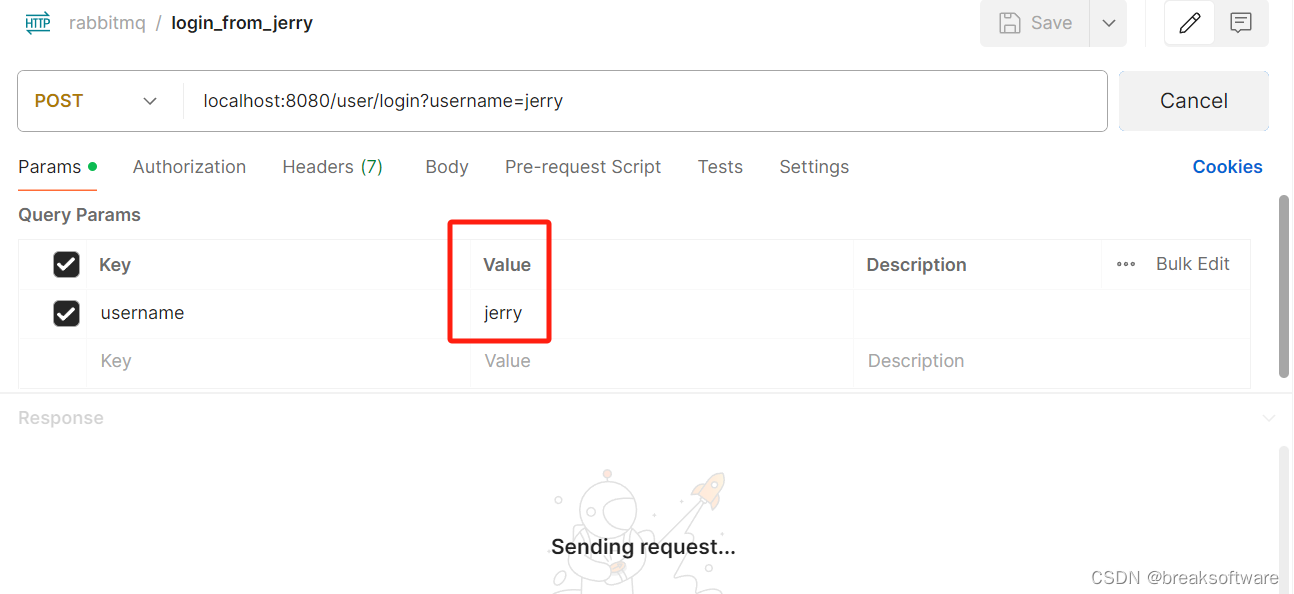
在后台,我们看到创建两个队列

以及Core交换器的绑定关系也被更新
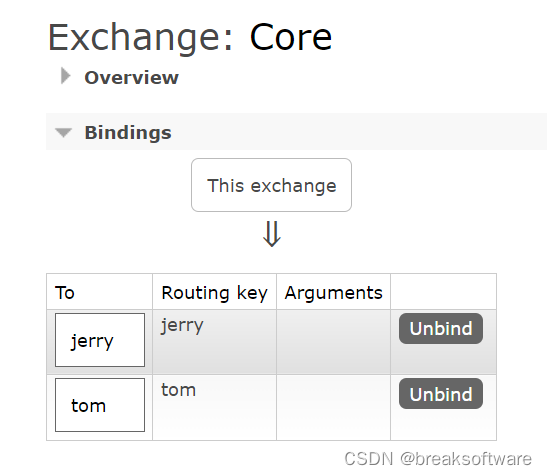
Jerry向Tom发起聊天邀请

可以看到Tom收到了邀请
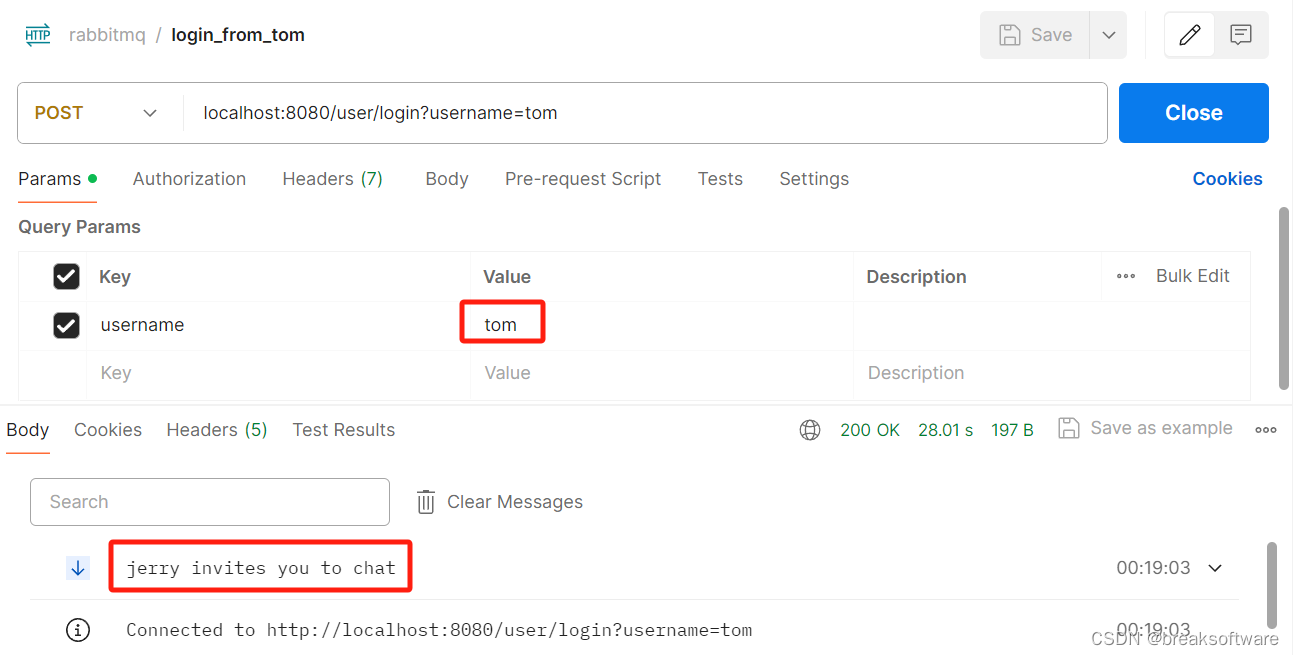
同时新增了两个队列

以及一个交换器

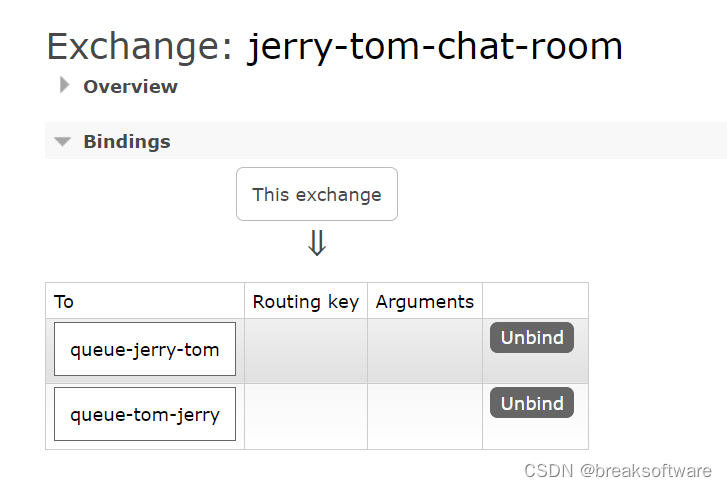
Tom通过下面请求接受邀请
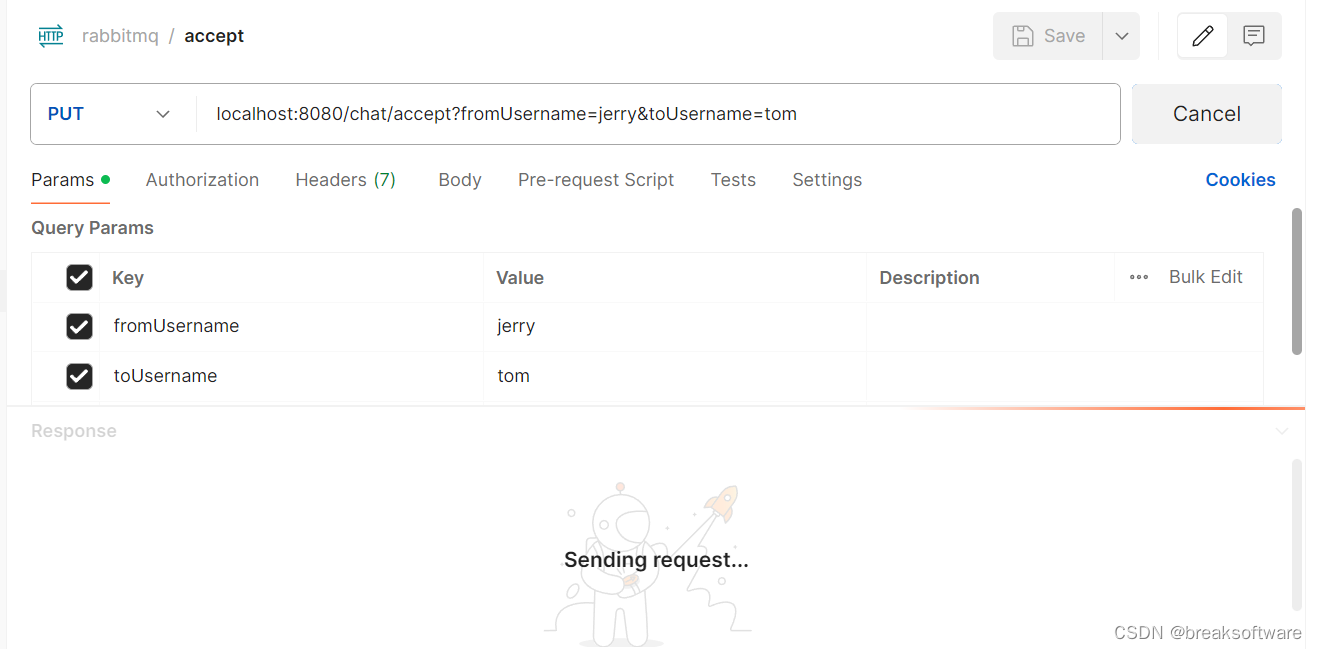
Jerry收到Tom接受了邀请的通知
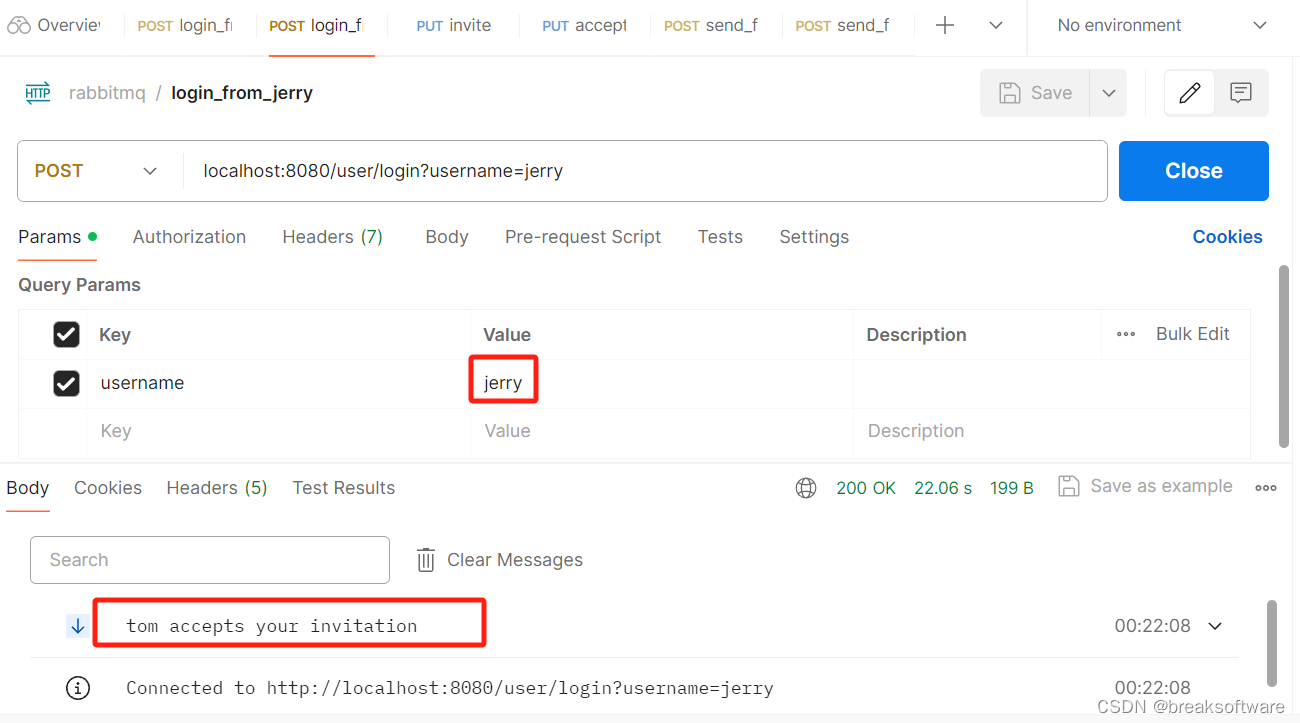
后面它们就可以聊天了
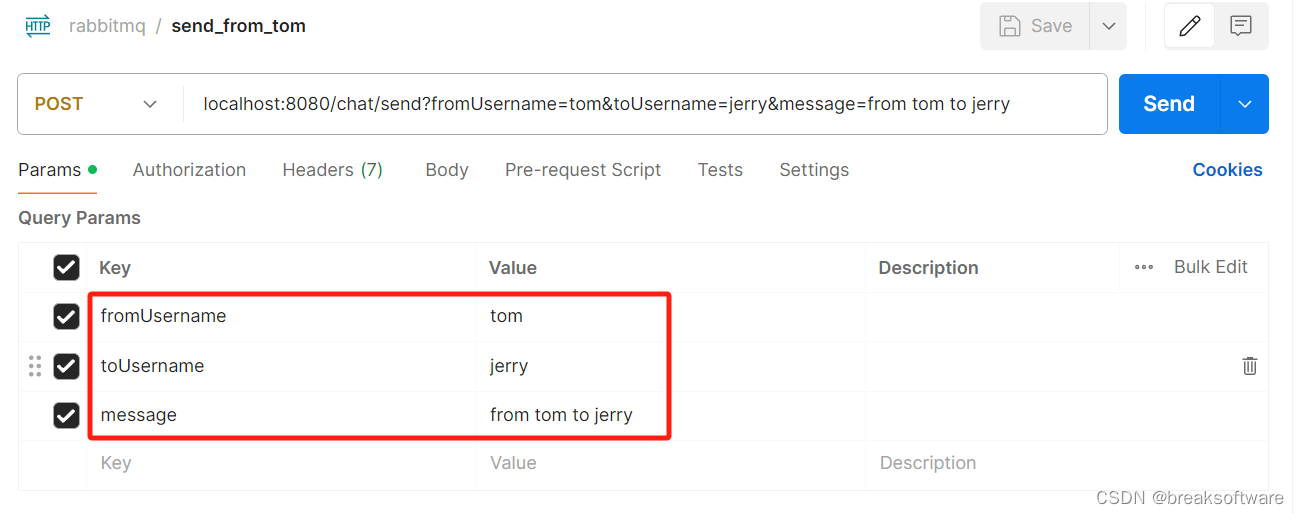
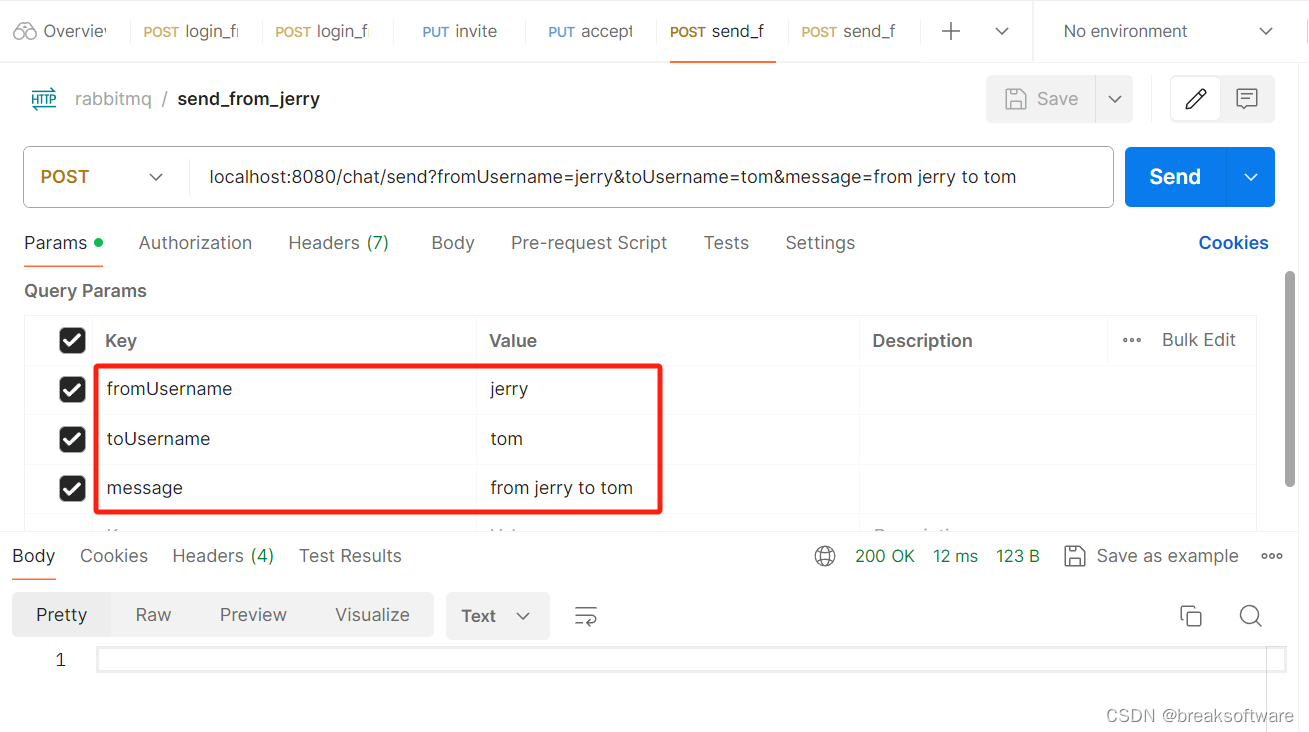
它们的聊天窗口都收到了消息

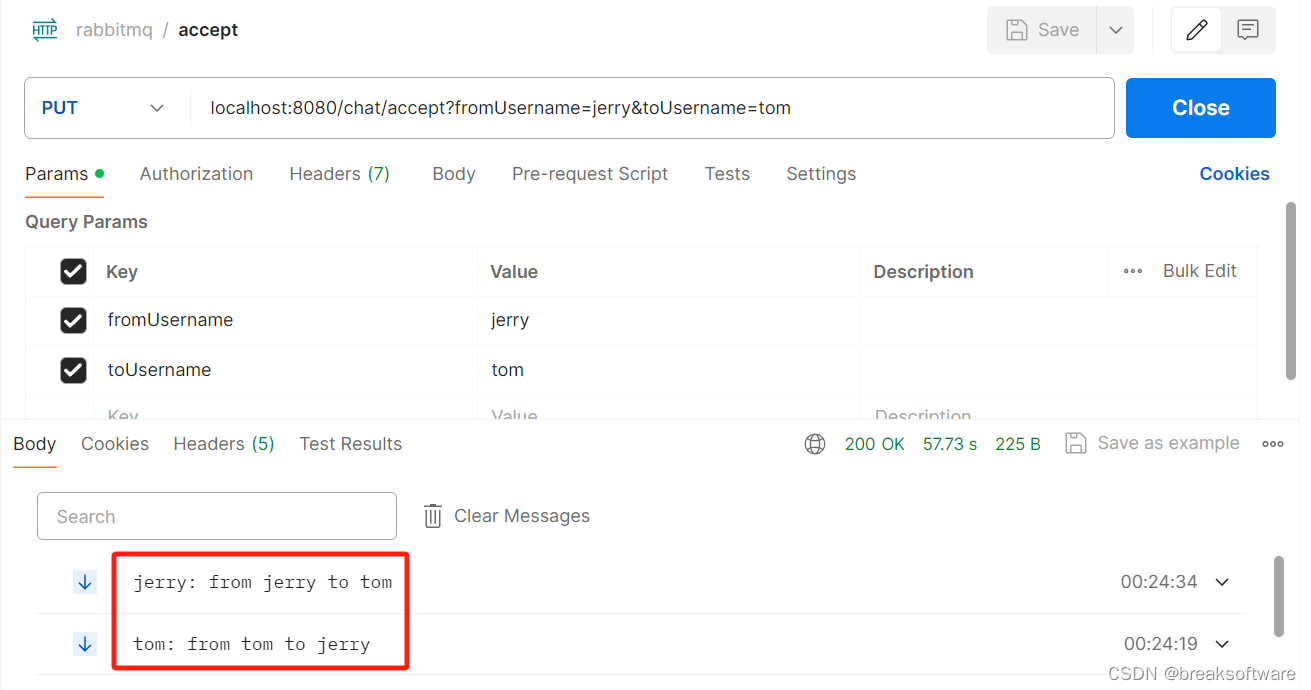
总结
本文主要使用的知识点:
- direct交换器以及其绑定规则
- fanout交换器
- 自动删除的交换器
- 自动删除的队列
- 只有一个消费者的队列
- WebFlux响应式编程